The Samsung C9000 series displays have kept a low profile since their unveiling at the January 2010 CES show. When you consider their high price (the 46″ UE46C9000 costs no less than £3000), that probably won’t come as much of a surprise. As the company’s top-tier model, this 3D capable, ultra-slim LED-sidelit LCD display features a Full HD 1080p panel, 4 HDMI inputs, and also ships with a unique touch-screen remote control.
<!-- google_ad_client = 'pub-2887677957235196'; google_ad_slot = '4990177225'; google_ad_width = 336; google_ad_height = 280; //-->
Can the Samsung UE46C9000 justify its premium price tag, or is it a needless extravagance? Let’s find out!
Note: Our Samsung UE46C9000 review sample was delivered with firmware version 2010/10/25_002000. This is the latest version at the time of review.
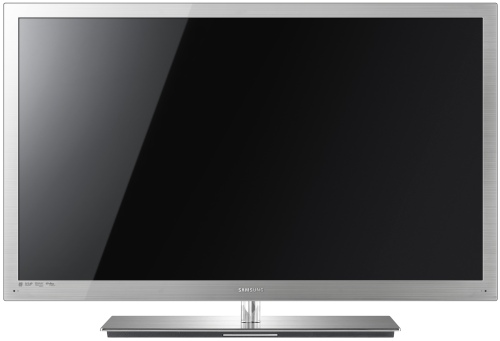
The Samsung UE46C9000 is certainly a stunningly engineered HDTV: with a screen that’s just 0.5cm deep, it truly is “pencil thin”. The 46-inch LCD panel is surrounded by a silver metallic bezel, and although we prefer black (for the perception of higher contrast that it gives on-screen images), we can’t deny that the design is aesthetically pleasing as well as technically impressive.
Unlike the step-down Samsung C8000 series 3D TV we reviewed, which sat somewhat precariously on top of a four-legged metallic stand, the C9000 is fixed to a thick silver stand. Due to the extreme thinness of the TV (it’s too thin to place any HDMI inputs on), this stand also serves as a “media box”: it’s where the television’s power feed, aerial, and video input hookups are located.
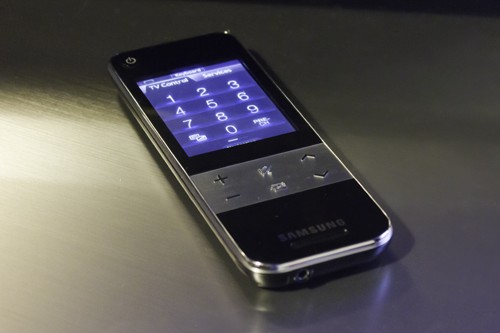
Also of note is the UE46C9000’s remote control, which more closely resembles a high-end touch screen phone than a television remote. We think that the possibility of watching TV on the remote screen is neat, although honestly can’t think of much practical use for it. Crucially, the remote control is more difficult and slow to use compared to the standard “plastic slab with buttons” variety. Given the amount of back-and-forthing we do in the menus during our intensive calibration process, we quickly put the fancy remote aside and grabbed the more responsive remote that came supplied with a cheaper Samsung LCD instead! (Samsung also ships the C9000 with a basic small remote that only features volume and channel options, making it of very little use).
Connectivity is rarely remarkable on modern HDTV displays – there’s no recent example we can think of that left us wanting much more. On its thick silver base, the UE46C9000 features 4 HDMI inputs, connections for SCART and Component devices (via supplied dongle cables), a PC “VGA” input, and aerial input for feeding the Digital TV tuner, and also 2 USB inputs, to which various devices can be attached.
 |
| Rear & Side: 4 x HDMI, VGA, component, SCART, aerial, USB, ethernet & audio outs |
Unsurprisingly, as Samsung’s top-tier HDTV for 2010, the UE46C9000 features the entire range of picture setup controls. As well as the basic adjustments you’d expect, there’s a basic [Gamma] option which allows a selection of one of seven different preset Gamma curves, a three-axis Colour Management system, basic 2-point Greyscale control, as well as advanced 10-point control for further fine-tuning.
![[Picture] menu](https://www.hdtvtest.co.uk/news/wp-content/uploads/2018/04/hdtv_Samsung-UE46C9000_picture.jpg) | ![[Picture] menu](https://www.hdtvtest.co.uk/news/wp-content/uploads/2018/04/hdtv_Samsung-UE46C9000_10p.jpg) |
| [Picture] menus |
As well as basic adjustments (for picking the correct signal format), the [3D] menu features control over [3D View Point] (which can be used to lessen or exaggerate the 3D effect), [Depth] (for controlling the intensity of 2D-to-3D conversion), and a mysterious [3D Optimisation] feature.
Note: Our Samsung UE46C9000 review sample was calibrated using Calman Professional, the industry-leading video calibration software.
Note 2: To keep the review pages concise, we’re no longer publishing Correlated Colour Temperature charts. The RGB Level Tracking charts show the same data, but in greater detail.
In its out of the box state, the UE46C9000 displays video that is certainly not in accordance to industry mastering standards. The result is missing shadow and highlight details, blue-tinted whites, oversaturated colours, and emphasised edges. After selecting the “Movie” picture preset, which appears to be Samsung’s attempt at an accurate picture mode, we measured the following data from the LED-lit LCD panel:
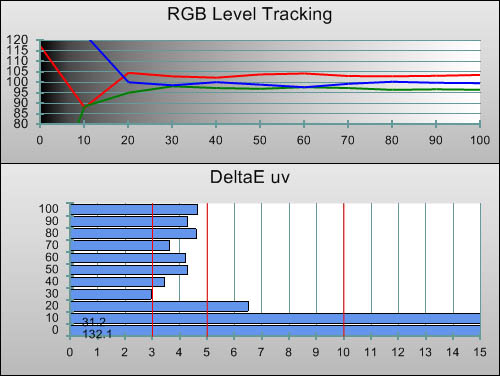 |
| Pre-calibration RGB tracking and delta errors (dEs) |
After selecting “Movie” mode, the Samsung UE46C9000 was doing a good job of reproducing the correct colour of grey. At all points, there was a slight bias of red and lack of green making up grey shades, and at 10% stimulus, there was a prominently visible excess of blue, meaning that shadowed areas of the picture looked overly cold. This is a common issue with LED-based LCD screens. Still, this is not a bad result at all, especially considering that no other calibration work has been performed on the display.
![Post-calibration RGB Tracking in [Movie] mode](https://www.hdtvtest.co.uk/news/wp-content/uploads/2018/04/hdtv_Samsung-UE46C9000_post-rgb.jpg) |
| Post-calibration RGB tracking and dEs in [Movie] mode |
Minimising Greyscale errors on the UE46C9000 was not difficult at all. First, we used the basic [White Balance] control in the TV’s menu. This screen features two sets of controls, one for low-end and another for high-end Greyscale tracking. Using only this control, it was possible to make an improvement, but we were still stuck with excessive blue at 10% stimulus, meaning shadowed areas of the image still looked “steely” and cold.
Using the [10p White Balance] calibration screen, we then attacked the remaining inaccuracies. As the results above reveal, we were able to achieve wonderful results, with a generally unnoticeable excess of blue remaining in dark areas. This is a visibly perfect result.
![Gamma curve in [Movie] mode](https://www.hdtvtest.co.uk/news/wp-content/uploads/2018/04/hdtv_Samsung-UE46C9000_post-gamma.jpg) | |
| Gamma curve in [Movie] mode | Corresponding gamma tracking |
“Gamma” describes the distribution of light output between the darkest and brightest parts of the image. After our initial calibration attempt, the “Gamma Y” tracking chart was still showing a peak upwards at 10% stimulus – indicating that shadow details were not as visible as they would ideally be. Fortunately, we were able to use the [10p White Balance] menu to rectify this, by simply adding 2 clicks to the Red, Green and Blue controls in the appropriate section of the menu which controls 10% stimulus. The end result? Practically ruler-flat Gamma tracking, a feat that few displays can accomplish.
Before calibration, the Samsung UE46C9000’s colour reproduction was already excellent. None of the six colours were obviously over/under-saturated or incorrectly tinted. In our quest for perfection, we used the three-axis colour controls that Samsung provide in order to push the LED TV to its absolute limits:
![Post-calibration CIE chart in [Movie] mode](https://www.hdtvtest.co.uk/news/wp-content/uploads/2018/04/hdtv_Samsung-UE46C9000_post-cie.jpg) |
| Post-calibration CIE chart with reference to HD Rec.709 |
![Post-calibration Luminance levels in [Movie] mode](https://www.hdtvtest.co.uk/news/wp-content/uploads/2018/04/hdtv_Samsung-UE46C9000_post-colour-lum.jpg) |
| Post-calibration colour luminance (coloured bars = targets; black bars = measured values) |
The results weren’t surprising at all: Samsung’s colour management controls are some of the best we’ve seen, and meant that we could correct almost all of the small Saturation, Hue, and Luminance (colour brightness) errors that existed in the UE46C9000’s images. The only exceptions here are Red and Blue, which both appear slightly desaturated on this television. This appears to be a common issue for LED-sidelit LCD sets, and unfortunately, Blues do appear slightly purple-ish to our eyes, since we’re used to watching nearly-perfect displays. Still, there are much worse colour errors that an HDTV could potentially show, so we don’t feel this is a huge problem – just one we’d rather not see on such an expensive display.
Methods for calibrating 3D TVs are still in their infancy, but it does indeed seem that the industry is pushing ahead with the same D65 white point and Rec.709 colour gamut as is used for 2D High Definition. After speaking recently with our calibration partners at Spectracal, we experimented with using Calman Professional’s screen offset feature for 3D calibration. In other words, we engaged 3D mode on the TV, displayed a test pattern (in this case, 80% white), measured, then repeated the measurement with the 3D shutter glasses, turned on, in front of our Klein K-10 colorimeter. Working out the difference (the offset) between these two measurements allowed for a much smoother 3D calibration process, since we no longer had to worry about the glasses shutting off (or the battery running out!) in the middle of calibration.
For reassurance, we did also measure with the glasses in front of the colorimeter, just as we’ve done for all our 3D reviews up to this point. This allowed us to confirm the accuracy of the offset measurements.
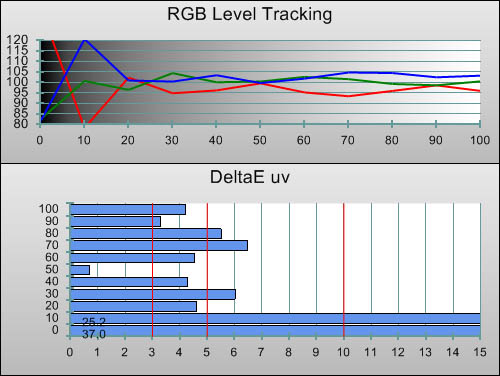 |
| 3D Pre-calibration RGB tracking and delta errors (dEs) |
We were largely happy with the quality of the Greyscale tracking in 3D mode, even before any adjustments were made. LCD-based displays have the advantage here over their Plasma counterparts, in that they appear much more able to display a consistent shade of grey at all brightness levels. The excessive amount of blue at 10% stimulus remained in 3D, and there was no satisfactory way of removing it, due to the fact that the [10p White Balance] control only works in 2D. In any case, this is certainly one of the better results of Greyscale Tracking that we’ve seen from a 3D TV.
![3D Post-calibration RGB Tracking in [Movie] mode](https://www.hdtvtest.co.uk/news/wp-content/uploads/2018/04/hdtv_Samsung-UE46C9000_3d-post-rgb.jpg) |
| 3D Post-calibration RGB tracking and dEs in [Movie] mode |
The Samsung UE46C9000 is another example of us not being able to produce blatantly superior Greyscale Tracking in 3D after calibration attempts. As you can see, the results we achieved were slightly superior at some points, but we made the blue-tinted 10% area worse. The biggest issue is the coarseness of the controls: just one or two clicks of the [-Offset] control (used to set low-end Greyscale) can introduce huge colour casts into shadowed areas. In the end, we admitted defeat and used the default [White Balance] settings, which, as the top chart indicates, are certainly some of the better results we’ve witnessed from a 3D display.
Although Samsung’s colour management controls allow for a huge level of control, the company’s 2010 displays have one design flaw: both 2D and 3D display modes share the same set of custom [Colour Space] controls. That means that unless you want to connect a dedicated 3D source device to another HDMI input on the 3DTV (since each input gets its own set of colour space controls), then you’re going to have to prioritise the quality of either 2D or 3D.
We chose 2D, since it makes up the majority of our viewing. As a result, we chose the [Auto] colour space mode, and then made all the improvements we could, without the fully-fledged [Colour Space] menu. This involved setting the [Colour] control (which mainly affects Colour Luminance) as well as the [Tint] control in order to balance the remaining inaccuracies. We were still able to get decent colour performance from the display, although Red remained noticeably undersaturated in 3D mode.
![3D Post-calibration CIE chart in [Movie] mode](https://www.hdtvtest.co.uk/news/wp-content/uploads/2018/04/hdtv_Samsung-UE46C9000_3d-post-cie.jpg) |
| 3D Post-calibration CIE chart with reference to HD Rec.709 |
![3D Post-calibration Luminance levels in [Movie] mode](https://www.hdtvtest.co.uk/news/wp-content/uploads/2018/04/hdtv_Samsung-UE46C9000_3d-post-colour-lum.jpg) |
| 3D Post-calibration colour luminance (coloured bars = targets; black bars = measured values) |
| Dead pixels | None |
| Screen uniformity | Excellent |
| Overscanning on HDMI | 0% with [Picture Size] set to “Screen Fit” |
| Blacker than black | Passed |
| Calibrated black level (black screen) | 0.00 cd/m2 (LEDs switch off) |
| Calibrated black level (ANSI checkerboard) | 0.058 cd/m2 |
| Black level retention | Stable with [Shadow Detail] set to +2 |
| Primary chromaticity | Excellent (2D) |
| Scaling | Excellent, smooth in 2D; below average in 3D |
| Video mode deinterlacing | Very effective jaggies reduction |
| Film mode deinterlacing | Excellent: passed 2:2 PAL |
| Viewing angle | Good, but Gamma and Greyscale shifts from sides |
| Motion resolution | Around 1080 with [Motion Plus]; 300 without |
| Digital noise reduction | Undefeatable noise/grain smoothing except in Game Mode |
| Sharpness | Defeatable edge enhancement |
| Luma/Chroma bandwidth (Blu-ray) | Full Luma, horizontally blurred Chroma except in Game Mode |
| 1080p/24 capability | No judder in 2D; 60hz judder in 3D |
| Input lag | 47ms in Game Mode & PC mode (2D & 3D) |
| Full 4:4:4 reproduction | Yes, with input labelled as “PC” |
| Default [Standard] mode (2D) | 166 watts |
| Default [Standard] mode (3D) | 190 watts |
| Calibrated [Movie] mode (2D) | 130 watts |
| Calibrated [Movie] mode (3D) | 189 watts |
| Standby | 1 watt |
Measurements taken with full 50% grey screen.
Immediately after turning on our Samsung UE46C9000 review unit, it became apparent that it does not follow in the footsteps of our UE46C8000 sample, and features the most uniform, “clouding”-free LCD panel that we’ve seen from Samsung in years. Yes, the extreme far left and far right edges of the panel were slightly brighter than the rest, but that’s really all. It marks the first time we’ve seen an ultra-slim edge-lit LED LCD TV from the company that doesn’t feature patches of uneven light marring dark areas, which bodes extremely well for the future (let’s just hope they can manufacture such high quality panels at cheaper prices). We sincerely hope that this is not only the case with our review sample, and that all units feature this same high panel quality (they should do at this price). Perhaps some C9000 owners can let us know how their screens look in the comments section?
Auto-dimming is also greatly reduced over the C8000 whose LED side-lighting would noticeably dim when the video signal being input to the TV became darker, which was often quite distracting. For example, the screen’s light output would zip up and down during a candle-lit dinner test scene, when one of the actors’ hands blocked the candle. We did catch the UE46C9000 dimming slightly at times, but setting the [Shadow Detail] control to its “+2” setting either eliminated or nearly eliminated this.
What hasn’t changed, though, is the level of contrast performance. When the LED LCD TV receives a fully black video signal, it will shut its LED lights off entirely (obviously in this case, the light output from the panel measures at 0.00 cd/m2). Of course, this is of no use in real world viewing, which is why we’re now performing measurements with ANSI test charts, which test how dark blacks appear when they’re displayed beside white areas. After ensuring that peak white on the Samsung UE46C9000 was calibrated to our standard 120 cd/m2, we verified that the black patches in the chart measured 0.058 cd/m2, which is enough to give the impression of deep blacks.
The viewing angle performance of the C9000 was noticeably better than the cheaper C8000, and for a VA-type LCD panel, was very good. When the panel was viewed from a side position, there was a visible Gamma shift, meaning that the picture appeared more grey-ish, with exaggerated shadow details. Greyscale characteristics also shifted, with certain shades – which looked absolutely perfect when sitting face-on – appearing a little pastel-coloured. However, these flaws are simply inherent to LCD display technology, meaning that viewers are probably more than used to them now. Whether or not they are tolerable is down to the viewer and the usage environment.
In our scrolling test chart, the Samsung UE46C9000 managed to hold onto 1080 lines of resolution, even during movement – at least in the area of the chart that displays grey lines. The exact resolution of the moving black lines was a little harder to settle on, but whatever it is, it’s suitably high. (Ah, for the days of LCD displays which could only manage 300 lines of motion resolution – back then, reading the chart with just our eyes was so easy!)
Of course, to achieve this high level of motion performance, the Samsung UE46C9000 had to have its [Motion Plus] system engaged. We set [Blur Reduction] to 10 and left [Judder Reduction] at 0 (to avoid the “soap opera effect” being introduced into films). Unfortunately, just as with the rest of Samsung’s 2010 LCD sets, we did notice this occasionally causing the on-screen image to stutter, especially around rapid scene cuts. A good indicator is any sort of news channel with a smooth scrolling headline ticker – in our case, the BBC News ticker would sometimes erroneously drop to half of the usual motion smoothness when the [Motion Plus] system was enabled.
We were surprised at how much better the 3D performance was on the UE46C9000 compared to the Samsung C8000 LED LCD display we reviewed back in May. Readers have told us that the 3D performance of that display improved considerably after firmware upgrades, but we’ve not had a chance to re-assess it. As a result, we’re unsure if the superior 3D performance we’re seeing now with the C9000 is the result of software updates, higher quality components, or both.
In any case, crosstalk is greatly reduced, which is very reassuring given just how damaging it has been on other LCD-based 3D televisions. Of course, it’s still not at the point where it could be described as a non-issue: during 3D Blu-ray discs such as Cloudy with a Chance of Meatballs and the various demo discs we’ve amassed over the months, there are still some instances of the dreaded black/white glowing. We were expecting worse, so this bodes well for the future. We do need to point out, however, that since the UE46C9000’s 3D display mode is 60hz-centric, 24fps movies displayed with some unwanted juddering.
Sadly, the situation is only so rosy when it comes to Full HD 3D content (the only sources right now for this are Blu-ray 3D and PC graphics cards). When feeding a Side-by-Side 3D signal to the TV, we found that the same poor quality scaling that we’ve witnessed on all of Samsung’s 3D range is present. It’s almost as if the 3DTV is interpolating every second pixel, meaning that areas of fine texture appear slightly messy and lacking in detail. We are at a loss to explain why this might be – a simple scaling operation surely shouldn’t result in this sort of arefacting (it certainly doesn’t on Panasonic’s and Sony’s 3D displays). Also, since the 3D modes of the UE46C9000 are still 60hz-centric, engaging 3D mode with 50hz high-motion video material reveals fairly obvious judder.
Although not as bad as Panasonic’s 2010 implementation, the user interface does still need some work when it comes to 3D. Unlike Panasonic’s, Samsung’s TVs do automatically load a different set of picture options when 3D mode is engaged (this is important, since 2D and 3D both need different settings for the best quality). Irritatingly, Samsung’s keeps reverting to the “Standard” picture mode, which was annoying for us, since we spent a lot of time calibrating the “Movie” mode for 3D and had to manually set the display to this mode each time a 3D film started.
Additionally, Samsung still haven’t fixed the bug where selecting the “Custom” [Motion Plus] mode with 3D content causes the picture to be overscanned, with the outer edges being cropped. This is bad for many reasons. First and most obviously, it means you don’t see the whole picture. Secondly, overscanning on a digital display involves resizing (scaling) the picture, which causes a drop in quality – especially because the three-dimensional scaling on Samsung 3D TVs is poor. Bottom line: make sure you’re using [Motion Plus] “Off” or “Clear” for the best quality picture from 3D Blu-ray discs!
On the plus side, though, since we mentioned Panasonic 3D Plasma TVs, we need to point out that the quality of the Samsung UE46C9000’s Greyscale tracking in 3D mode is much better than any Plasma display we’ve measured. This results in images being free of unwanted colour casts (except for the aforementioned excess of blue in shadowed areas). Although they’re winning the battle on Crosstalk artefacts, Plasma TV panels appear to have a very hard time maintaining clean, bright, linear images with smooth gradation when it comes to 3D.
Unsurprisingly, the UE46C9000 contains the same wonderful SD-to-HD conversion processing that’s seen on most of Samsung’s TV range. Due to the similarities in performance, we’ve reproduced the explanation below from a previous review.
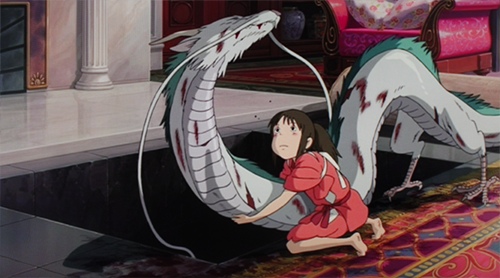
Video deinterlacing of 480i, 576i and 1080i SD and HD formats was excellent, with almost no jaggedness making it onto the screen. The look of Samsung’s scaling engine (which performs the actual resizing of SD signals to the HD panel resolution) may be something of an acquired taste, since its edge-adaptive nature means that it ends up producing a more natural picture, rather than a pin-sharp one. For example, other scalers will produce an incredibly sharp picture with some aliasing (jaggedness) present, whereas Samsung’s tends to smooth over such imperfections and present a smoother, more believable image instead. Neither is necessarily better than the other, and personally, we like the look of both.
Film mode detection is also present and working correctly. The Samsung UE46C9000 properly detected PAL 2:2 film material, and presented it with full vertical detail and no jaggedness. The SD handling on this HDTV is really just about as good as it could possibly be.
The UE46C9000’s HD images, for the most part, look very good indeed. The LCD panel’s high level of contrast performance combined with the linear and accurate Greyscale tracking, and accurate colour performance, mean that 2D high-def material has a sense of involving depth.
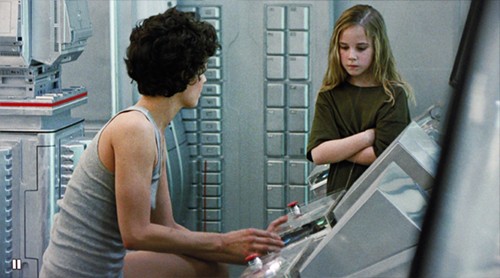
Unfortunately, HD material doesn’t reach the screen entirely untouched. Just like most of Samsung’s 2010 TVs, the C9000 partakes in temporal smoothing, meaning that it attempts to average out moving details in the picture that it deems to be unwanted noise. This also results in film grain (something similar to, but not necessarily the same as noise) being smoothed over. This is bad, because it changes the look of the material and at times causes artefacting. At times, the smoothing can be barely noticeable, but it can make some films look un-textured and flat. It’s important to note that this is not a technical limitation of the television (we’d be more forgiving if it was), but deliberate revisionism on the part of Samsung’s engineers. The control here should be in the hands of the customer, especially on such an expensive display.
Because the noise reduction is motion-adaptive, it means that the amount of grain seen will vary depending on the picture content (it also means you can see the original image if you pause your Blu-ray Disc player). For example, at the start of chapter 17 of the Aliens BD, the scene is lacking its film-like texture – until a cloud of smoke rushes past the camera, which brings powdery remnants of the grain back momentarily. This is a shame, because LCD screens are especially suited to reproducing film material with grain, without any additional “tizzing” or dithering like a Plasma television adds due to its driving method. Later on in Chapter 18, the heavy grain in darker scenes cannot be fully removed by the smoothing processing, meaning that what’s left of it looks more like noise, and “swarms” and “smears” around in the dark. This scenario will please nobody: those who like to see films looking like films won’t be appeased, and those who dislike the look of film grain will probably have their attention drawn to it more.
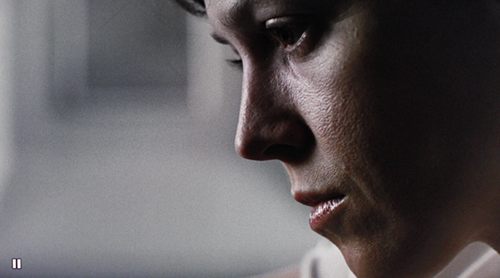
As with the Samsung PS50C6900 Plasma, the solution to return full detail and film texture is to use the [Game Mode] option, but unfortunately this results in 24p material replaying with pulldown judder, meaning that it’s not a completely acceptable fix. It also means that users lose access to the [10p White Balance] function. Still, there will be some users who will still prefer these limitations over the smoothing. Although the image could still look very good, users shouldn’t be forced into compromising on such an expensive HDTV. Samsung, we’re impressed by the noise reduction system and think it does wonders with poorly lit video material (or noisy analogue TV broadcasts, in countries that haven’t moved to digital broadcasting), but for movies being played from a high quality source, we just want to see the image without revisionism. Surely a screen of this cost should be a “no compromises except where absolutely necessary” product.
With this out of the way, we need to say that the image quality delivered by the UE46C9000 is still very good indeed, provided that the material you’re watching doesn’t draw attention to the aforementioned smoothing process (or if the viewer simply doesn’t notice it). For example, CG animated films, which are almost always visibly grainless by their very nature, looked excellent. One of our favourite 2D animation discs, Ponyo (which actually does have some subtle digitally added grain, for aesthetic reasons) still looked wonderful. The clean look of the LED LCD TV and the absence of any noticeable black smearing added up to produce an impressive image.
After engaging the [Game Mode] option, we gave some of our favourite Xbox 360 games a spin on the Samsung UE46C9000. Sadly, the flagship TV follows in the footsteps of other processing-heavy displays and does exhibit input lag. In both 2D and 3D display modes, we measured the lag as being around 47ms, which is enough to make games feel a little sluggish to users used to playing them on fast displays. However, things were by no means unplayable.
We were expecting the Samsung C9000 to simply be a thinner version of the step-down C8000 – a display which we weren’t totally enthusiastic about when we reviewed it in the Summer. As it happens, the UE46C9000 does manage to improve on some of the shortcomings of its cheaper sibling. In the review sample we received, panel uniformity was excellent. Furthermore, auto-dimming during dark scenes was no longer an issue, and there was no judder in 24p material (during 2D playback). Also, crosstalk in 3D material is greatly improved over the C8000 we reviewed back in May – although if this is the result of firmware upgrades, it’s possible that the C8000 will have the same performance now, too. Let’s also not forget about the wonderful Greyscale, Gamma and Colour performance, all of which lend on-screen images a heavy dose of depth and realism.
Unfortunately, the more expensive a display is, the harder it gets to tolerate shortcomings. The customer isn’t given complete control over the annoying texture-blurring smoothing process, the touch-screen remote is frankly annoying (we opted to use the remote from a cheaper Samsung TV instead), there are still issues with 3D performance from Side-by-Side sources, and it’s not an ideal screen for gaming thanks to some input lag. Few HDTVs are worth £3000, but we don’t feel that Samsung has done everything in their power to justify such a high asking price.
Still, we’re impressed that crosstalk in 3D is kept to a surprising minimum compared to other LCD-based 3D sets we’ve seen, and we’re also glad to see that Samsung can produce an ultra-slim panel without obvious screen uniformity issues. As a result, we look forward to seeing improvement such as these (and fixes to the other issues we outlined) make their way onto cheaper Samsung HDTVs in the future… because Samsung has made some truly excellent value-for-money displays in the past.

<!-- google_ad_client = 'pub-2887677957235196'; google_ad_slot = '0693194791'; google_ad_width = 336; google_ad_height = 280; //-->